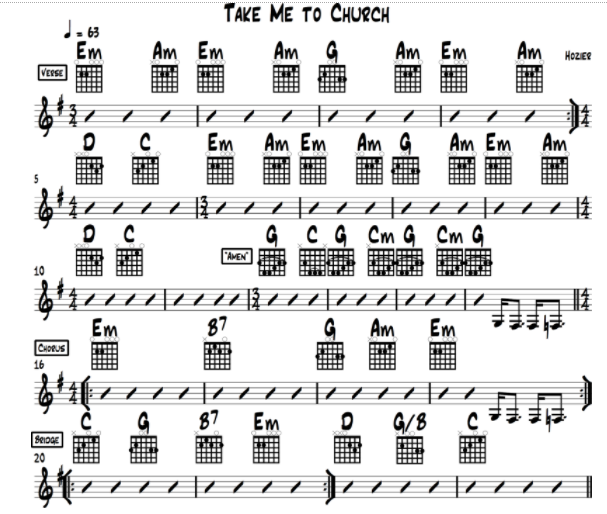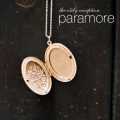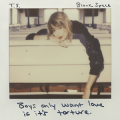Easy Guitar Chords Arranged for Beginners
“Take Me to Church” is a song by Irish musician Hozier for his debut extended play (EP) Take Me to Church (2013), as well as his self-titled debut album (2014). The song was released as his debut single on 13 September 2013. Hozier, a struggling musician at the time of this song’s writing, wrote and recorded the song in the attic of his parents’ home in Bray, County Wicklow, Ireland. A mid-tempo soul song, its lyrics detail Hozier’s frustration with the Catholic Church and its stance on homosexuality. It first caught the attention of independent label Rubyworks, where producer Rob Kirwan overdubbed the original demo with live instruments. Only two musicians are featured on the track, Andrew Hozier-Byrne (Hozier) and drummer Fiachra Kinder.
Useful links:
Lyrics and Chord Tabs
Song Specs
 Title: Take Me to Church
Title: Take Me to Church
Artist: Hozier
Songwriters: Andrew Hozier-Byrne
Album: Take Me to Church
Key: Em
Tempo: 63
Chord Progression: Em–Am–G–D–C–B7
Accompaniment Technique: Open Chords and Simple Strums
Playing Tips
Here are some helpful tips to keep in mind that will help you learn the tune faster while giving you some ideas for how to approach performing it. I provided some useful links above and I’ll take you through the chords, accompaniment patterns, song form and a chord chart. Everything you need to get started playing this tune.
Take Me To Church Chords
| Chords | Em | G | Am | B7 | C | D |
| Progression | i | bIII | iv | V | bVI | bVII |

“Take Me to Church” is in E natural minor for the Verse, hints at E harmonic minor for the Chorus with the Bridge in C major. It also has an interesting song form, in that, the Verse is in 3/4 time and is made up of a four-bar chord riff that’s connected with the D and C chords and a time change to 4/4. It’s creates an interesting mood change. The Verse then ends with an “Amen” Refrain.
There’s also a descending riff that’s played on the 6th string that’s used to connect the Verse and the Chorus. And, the rest of the tune concludes with conventional songwriting techniques.
Once you get past the time changes and somewhat unusual Verse structure you’ll find “Take Me to Church” is a fun and easy tune that you can quickly add to your repertoire. It’s also a great tune for those venturing into the world of singing while playing. The open chords and simple strumming patterns lend themselves to working on these skills.
Accompaniment Techniques
I suggest using a combination of downstrums with the open chords for the Verse. Then, add targeted strumming for the Chorus and Bridge sections. Let me explain this further:
- Targeted strumming is an alternate strumming technique.
- Split the guitar into two string sets: the low strings (strings 4-5-6) and the high strings (strings 1-2-3).
- Try to imitate the bass and snare of the drum pattern. Bass = low strings, and snare = high strings.
- Use the boom-chick and/or the boom-chicka techniques as your starting point.
The Boom-Chick Strumming Technique
Let’s use an alternate (down and up) strumming technique for “Take Me to Church”. Amongst guitarists, this technique is referred to as the boom-chicka pattern. Here’s the breakdown:
- The “boom” is the bass (lowest note of the chord) played with a downstrum .
- The “chicka” is the higher part (the top 2 or 3 strings) of the chord also played with alternating strums (down followed by up).
- Downstrum on “chick” and the upstrum on “a”
There’s a boom-chick technique that is the basic version of the boom-chicka. And, the boom-chick only uses downstrums: bass-chord, bass-chord; or, boom-chick, boom-chick.
When hitting the bass (boom), you aim for the lower part of the chord (or the bottom three strings). Then, for the chord (chick), aim for the higher three strings.
Also, you don’t need to strum too hard. Brush the strings and try to recreate that bouncy feel that is a key component of the song.
Chord Chart
I’ve included a chord chart, which is a simple road map that shows you:
- The overall arrangement of the song.
- A section by section breakdown of the song.
- Each chord and how long to play it for.
If you don’t read music, please don’t be intimidated. This is a cheat sheet that can help you get through the tune quickly and easily. I find it indispensable for learning songs and I can also hand it to a seasoned musician and they can follow along without any problems.
Song Form
- Verse: A 4-measure chord riff that’s played twice; The four-bar riff is in 3/4 time and can be viewed as Em–Em–G–Em with an Am chord played on beat 3 of each measure. There is a measure of D–C with a time change from 3/4 to 4/4 before the 4-measure chord riff is played a third time. This is followed by a 4-bar Refrain (the “Amen” part). Then, a chromatic, descending riff brings us into the Chorus.
- Chorus: A 4-measure section that’s repeated; Measure 1 is Em, Measure 2 is B7, Measure 3 is G for two beats and Am for two beats, and Measure 4 is Em for two beats followed by the descending riff.
- Bridge: A 10-measure section; first a four-bar chord pattern, C–G–B7–Em that’s repeated. This is followed by two beats of D and two beats of G/B. The final measure is four beats of C.
Once you become familiar with chord charts, you’ll never want to go back. It’s just easier to see where you’re going when you have a map. And, it’s especially helpful when you’re not familiar with the song or there’s a section of the song that you don’t remember (Bridges and Interludes are notorious for surprising players and derailing a song’s performance). This tune has a Bridge complete with a key change and strumming feel.

Wrap-up
I hope that you’ve enjoy learning Take Me to Church chords. This is a beautiful tune that turns heads as most audience members recognize it but aren’t expecting to hear it. It’s also a beautiful piece of songwriting with a powerful message.
I appreciate you checking out this lesson. Thank you for hanging with me and I’ll see you next time.







